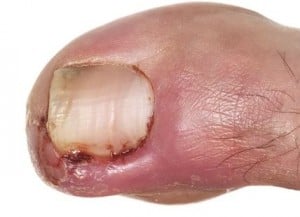Ingrown toenail symptoms such as redness, numbness and swelling of your toe nails can make you very uncomfortable. Not to mention, you can be in deep pain and lose sleep. Here is a list of the symptoms and signs of ingrown toe nails.
Having an ingrown toenail is not your idea of fun; it is not my idea of fun either. This article will highlight some of the common symptoms associated with this nail disease. We’ll also highlight how to go about treating that annoying ingrown toenail and say goodbye to the awful pain. Included also are some of the tell-tale signs of infection to the ingrown toenail.

Ingrown Toenail Symptoms
Medically known as Onychocryptosis, an ingrown toenail is simply put a toenail that has its edges pressing or growing into the surrounding skin and soft tissues. Injury (such as stubbing your feet on the ground), toenail infections, excessive sweating and poor foot hygiene, inappropriate cutting of nails, and wearing ill-fitting shoes can all lead to the development of ingrown toenails.
It can affect any toe but the big toe is the one that most commonly fall prey. So, what are some of the ingrown toenail symptoms that you can expect should this common nail problem knock on your door so to speak?
Pain is perhaps the most recognizable symptom of ingrown toenails and is what brings it to the attention of most patients. Pain can be especially severe if the toenail gets an infection. Redness, tenderness and swelling are as well early symptoms of ingrown toenail. These result in a reddish, tender lump that overlaps the edge of the nail.
In some instances, the ingrown toenail can lead to clear, yellowish discharge which typically turns to pus (yellowish green) if an infection of the toenail occurs.
Ingrown toenail symptoms can be experience on either one or both sides of the toe and may worsen as the nail continues to grow into the soft tissues or gets infected.
For example, when the ingrown toenail gets infected, the tender feel and the reddened look of the skin surrounding it often gets exacerbated. The redness can continue as to cover almost the whole toe.
Ingrown Toenail Infection Symptoms
An ingrown toenail can get infected if not properly treated, and early enough for that matter. This can happen when the piercing of the soft tissue around the nail creates an entry point for bacteria.
Increased pain is one of the most common ingrown toenail infection symptoms. The affected area can also feel warm due to bacterial activity taking place there. It is also likely that the redness starts spreading through the infected toe.
Pus is also a common symptom for ingrown toenail infection. This is usually a yellowish-green discharge. If you notice a discharge of pus in your toenail, you should avoid the temptation to prick it with a sharp object to remove the pus in it since this can worsen the situation.
Instead you should see a doctor immediately. It is very likely that your doctor will treat you with a dose of oral antibiotics or give you a topical antibiotic cream (or ointment for that matter). Some pain relievers such as paracetamol may also be thrown into the mix.
Ingrown Toenail Symptoms Numbness
If an ingrown toenail is accompanied by numbness in addition to the other symptoms, then you should seek the attention of your doctor immediately as this is often a sign of a more severe infection.
According to the Foot Group website, severe cases of ingrown toenail infection can be characterized by subsiding of pain due to a change of the environment in which the bacteria breed and numbness to the local nerves.
The WebMD website adds to the point saying that individuals with vascular problems, diabetes, or numbness in the toes should seek immediate treatment as they are more susceptible to developing “…serious complications, including the risk of losing a limb.”
Ingrown Toenail Symptoms Redness and Swelling
In addition to pain, redness and swelling are some of the earliest symptoms of ingrown toenails. This is to mean that you should not be worried about “ingrown toenail symptoms redness and swelling” as one of our readers described it in an email.
You should only be concerned if the redness seems to be covering a progressively larger area of the skin as this can be a sign of infection. If that is the case, you should see you doctor immediately more so if it is accompanied by oozing of pus and the area feels warm.
Ingrown Toenail Symptoms and Treatments
One of the questions asked very often in my favorite online forum is “What are some of the common ingrown toenail symptoms and treatments?”
As we have already discussed in a previous section of this article, redness, swelling, tenderness and pain are the main symptoms associated with this nail condition.

These symptoms usually go away in a few days with proper treatment as follows:
- Place your toenails in warm soapy water for between 10 and 20 minutes
- Once the affected area is dry, apply a dab of OTC antibiotic cream
- Slide a small cotton wool in between the toenail and skin underneath it to separate them. replace it at least once every day
- Repeat this procedure 2 to 3 times everyday for a few weeks and refrain from trimming your toenail till it grows past your toenail. Once it has and it’s time to trim it again, cut It straight across and refrain from rounding the edges as we are accustomed to. It is true short rounded toenails looks fabulous but trimming the toenail that way is one of the common causes of ingrown toenails.
You may also want to take over-the-counter painkillers such as paracetamol or acetaminophen to relieve the pain. It is also advisable to wear open shoes, sandals, or shoes with generous room for the toes as the problematic toenail heals to avoid putting pressure on it.
If the symptoms however don’t seem to have improved significantly a week later, see a podiatrist (a medical professional who specializes in treatment of foot conditions).
 eTopical Precious Finds
eTopical Precious Finds


